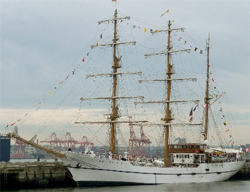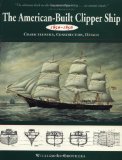Tall Ships Gold Rush Race The Guayas

° Index ° Eagle ° Guayas ° Hawaiian Chieftain ° Kaiwo Maru ° Deep Sea Derby, 1852 ° Levy's Log
Sail San Francisco 1999
The Guayas is a sail training ship of the Ecuadorian Navy. Launched in 1976 it was named in jointly in honor of Chief Guayas, the Guayas river, and Guayas, the first steamship that was constructed in South America in 1841 and is displayed on the Ecuadorian coat of arms. The ship's home base is Guayaquil, Ecuador.
As a participant in the 1980 Tall Ships Races, she earned the American Sail Training Association Cutty Sark Trophy for international friendship.
Based in Guayaquil, the 257-foot-long three-m ast bark carries eighty cadets under the guidance of thirty-five officers and experienced crew.
ast bark carries eighty cadets under the guidance of thirty-five officers and experienced crew.
The Guayas was in San Francisco for Tall Ships 2002.
She is a three-masted barque with a steel hull.
- Length: 48.40 meters (158.7 feet)
- Width:: 10.70 meters (35.1 feet)
- Draft: 4.50 meters (14.7 feet)
- Main Mast: 38 meters (124.6 feet)
- Sail Area: 1611 meters
- Crew: 235 (sailors, cadets, about 30 officers)
- Owner: Armada del Ecuador
The Guayas is one of four sailing ships that were built by Astilleros Celaya S.A. in Bilbao, the Gloria (Colombia) being the most similar ship.

Tall Ships: The Fleet for the 21st Century
Thaddeus Koza
This new and revised edition includes photographs and descriptions of over 175 vessels, including the major class 'A' ships along with many class 'B' and 'C' vessels from around the world. These are the tall ships of today and can be seen at major world ports during the years. Organised alphabetically, the book offers an impressive photograph of each vessel, supplemented by photographs of details ranging from figure heads and binnacles to flags and rigging. The text describes each ship featured, its history and notable events under sail, along with its technical specifications. This unique guide is an ideal book for everyone interested in these elegant vessels, their enduring history and traditions.
Tall ship rigging includes: Two-Masted Schooners, Brigantines, Topsail Schooners, Full-Rigged Ship, Barquentine, Three-Masted Schooners, Brig.

Sam Jefferson
More than 200 paintings, illustrations, and thrilling descriptions of the adventures and races on the water. First-hand accounts, newspaper reports and log entries.

American Built Clipper Ship
1850-1856 Characteristics, Construction, Details
William L. Crothers
Pacific Marine Review:
The National Magazine Of Shipping, Volume 19
Pacific American Steamship Association
China Tea Clippers
George Frederick Campbell
The history of the China tea clippers is examined, especially their struggle in the 19th century for economic survival in the face of the steamships. It also details advances made in design, hull construction, rigging, sail plans and deck arrangements.
American Clipper Ships:
1833-1858
Adelaide-Lotus
Volume 1 covers all American Clipper Ships built from 1833-1858 whose names begin with the letters A through L, and Volume 2 covers from M through Y. The criteria used to define a Clipper Ship, which is a ship "...of peculiar construction, designed for great speed rather than for capacity." (p.v) The authors consider the Ann McKim launched at Baltimore in 1833 to be the first Clipper, and the era of the Clipper to be over by 1858 with the launching of The Star of Peace at Newburyport. The books are basically listings of all 352 known Clipper Ships arranged alphabetically. Clipper ships, in addition to being exquisite vessels, were beasts of burden. Their loaded holds raced around the world; first goods in a foreign port -- San Francisco being a "foreign port" at that time -- brought in the highest returns.
The Deep Sea Derby of 1852 featured 95 clippers racing from northeastern ports, around the Horn, to San Francisco.

(Dover Maritime)
Frederick C. Matthews
American Merchant Ships 1850–1900 was written and compiled early in the twentieth century, when the halcyon days of merchant sailing were still easily within recall. Meticulously researched, with many verbatim accounts taken from contemporary sources, the text was reviewed wherever possible by the ships' builders, owners, and captains.
Unlike the older and faster clippers, these wind-driven leviathans, most of them built in Maine, were constructed to carry heavy cargoes, yet were amazingly swift, the later-built ships closely approaching records set by their famous predecessors. Here are enthralling accounts of life and death aboard ship as these fabled craft fought fierce winds and turbulent waters, penetrated ice floes, sat out long ocean calms, dodged icebergs, and rounded the treacherous Horn. Here, too, are details to warm the hearts of naval historians and sailing-ship enthusiasts alike: ships' dimensions, tonnage, launching dates, speed and length of voyages, cargoes, commanding officers, and much more.

American Merchant Ships and Sailors
Willis John Abbott
A chronicle of the high courage, the reckless daring, and oftentimes the noble self-sacrifice of those who use the Seven Seas to extend the markets of the world, to bring nations nearer together, to advance science, and to cement the world into one great interdependent whole. Willis John Abbott (1863-1934), American journalist and author of several maritime books, gives a detailed account of the history of merchant shipping in the United States.
The Old Merchant Marine:
A Chronicle of American Ships and Sailors
Ralph Delahaye Paine
The Clipper Ship Era
An Epitome of Famous American and British Clipper Ships, Their Owners, Builders, Commanders, and Crews
1843-1869
Arthur Hamilton Clark
Two Years Before the Mast
Richard Henry Dana, Jr.
Dana's father received a law degree from Harvard and eventually closed his practice in favor of his literary leanings. Dana also attendard Harvard and developed into a fine writer. After his sophomore year he contracted measles, which affected his eyesight and forced him to leave Harvard because he could not read. Not wanting to add to his father's financial difficulties, he joined the crew of a ship called the "Pilgrim" and sailed around the Horn to California's West Coast just prior to the Gold Rush. This is his journal of his two years "before the mast" (ordinary sailors lived in the front of the ship) that became an international sensation.
The Seaman's Friend: A Treatise on Practical Seamanship
(Dover Maritime)
Richard Henry Dana, Jr.
(Not necessary well-regarded given today's competition of illustrated books which better impart a sense of sailing durin gthe 19th century. It is here because of the value of Dana's Two Years Before the Mast.
Visions from San Francisco Bay
Czeslaw Milosz
Interrelated essays by the Nobel Laureate on his adopted home of California, which Lewis Hyde, writing in The Nation, called "remarkable, morally serious and thought-provoking essays, which strive to lay aside the barren categories by which we have understood and judged our state . . . Their subject is the frailty of modern civilization.



 Copyright © 1998-2017.
Copyright © 1998-2017.